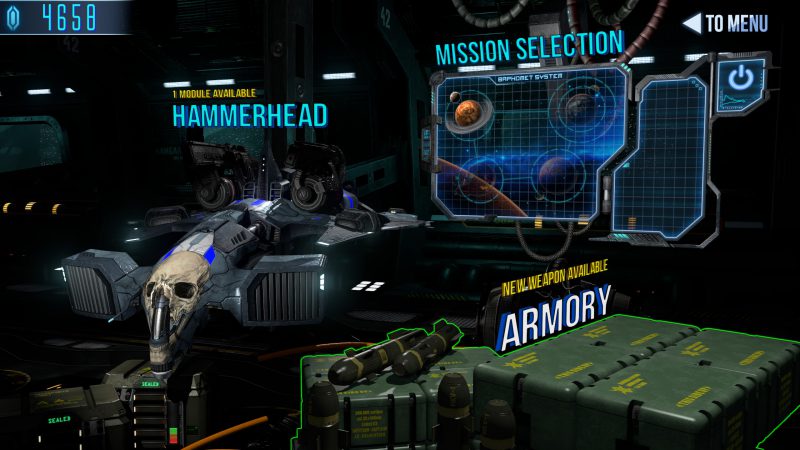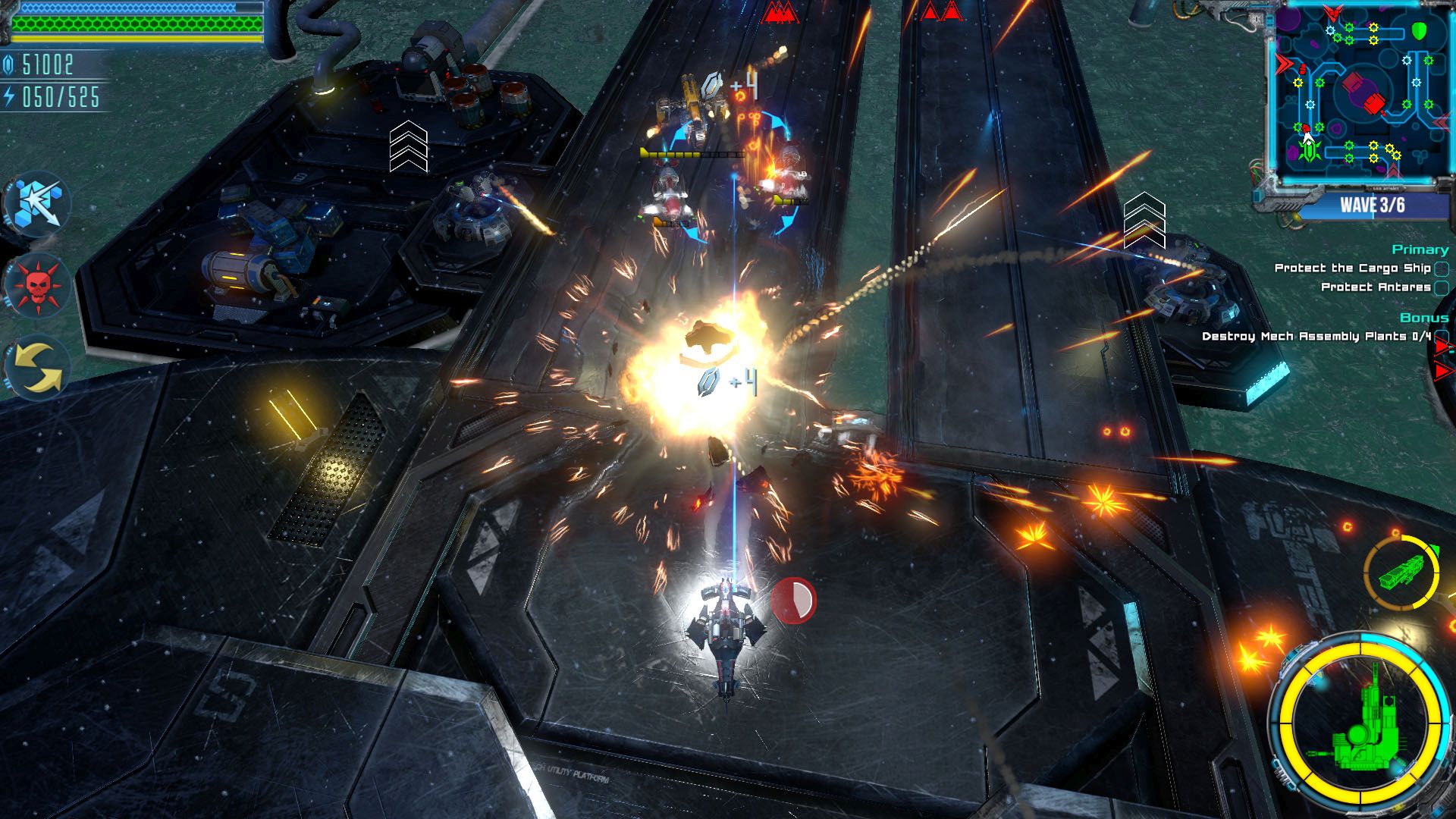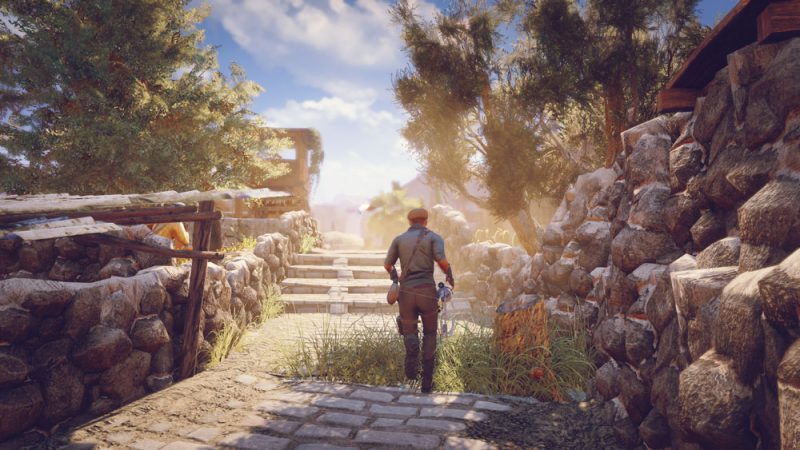Excubitor is one of the more clever takes on old-school, top-down shooting we’ve seen in some time. After a few minutes with the game, its mix of classic arcade-style gameplay with modern tower defence mechanics seems so logical, you’ll wonder why there haven’t been more attempts at this cross-genre combination.
In the 22nd century, a wormhole appears and creates a bridge to a remote system on which the greatest mineral is found. By 2182, several planets are colonised with the sole purpose of harvesting this mineral, known as the "voidshard," which provides mankind with all of the energy it will ever need. Around this time, a ship called the GRB Anteres is stationed on the planet Farris with the intent to research new deposits of the voidshard, but receives a distress signal from a nearby base on the planet’s surface. This is where the game begins.
The game is generous enough to give you the option of playing the tutorial. If you’ve never played Excubitor before, I highly recommend playing the tutorial to get the hang of it. Similar to other tower defence games, you have a limited number of resources with which you can use to build towers at designated locations on the map. However, instead of just moving a cursor around the map, you actually fly your ship, the Hammerhead, around the map to not only place turrets and such on the map, but also take part in the battles yourself.
As you’re flying around, placing turrets and taking down enemies, you’re doing all of this while guarding the Anteres. You can see its health and shields, so you have an idea of how much damage it can take before you really need to take out the enemies surrounding it. The Anteres can sustain a decent amount of damage as long as it’s not completely swarmed with enemies. But you still need to keep an eye on it as once it does get swarmed. It’ll go down rather quickly. The main goal is to protect the ship until you clear out each wave of enemies, simple as that.
The Hammerhead starts out equipped with two machine guns that are fired with the mouse buttons. As you fly around the map, you’ll use the mouse to hover your aiming reticule over an enemy; when it turns red, you can fire your weapons at it. This can seem a little strange at first since if you’re not aiming at an enemy as you’re firing—your shots won’t hit it even if the shots are going in the same direction that the enemy is in. However, it doesn’t take long to get the hang of this mechanic. Plus the tutorial also helps as you can somewhat play it as much as you want, which comes in handy for the next thing to discuss: upgrading the Hammerhead.
When you're set for battle, the mission select screen presents a detailed breakdown of the scope of the mission and then you're off. I will say that Excubitor surprised me with the amount of backstory and explanation that was provided about the star system, the ships, and events. Much of this could have simply been left out or glossed over, and for the type of game it is, it probably wouldn't have mattered a great deal. But that Tesseract put the time into creating a more well-rounded universe is noted and appreciated. Anyway, once deployed in battle, Antares' AI will inform you of the objectives, typically this boils down to "protect Antares until its specific mission or task is done." Often times there are some type of environmental aid that the player can leverage to help repel the onslaught of enemies.
These can be a device that you have to physically fly over to and activate from time to time or maybe a defensive structure like hiding behind a large asteroid during the first boss battle. In addition, there is typically a Bonus objective available that forces you to juggle your time extra carefully, but can yield extra Voidshards and a higher mission rank. Fortunately, the playable areas tend to be fairly tight so it doesn't take but a few seconds to fly from one end of the 'arena' to the other. Dodge and Turbo controls mapped to the Bumpers, i played using my Xbox one controller, are vital for zipping about the map and dodging incoming fire.

Simply firing back with your own guns and those automated turrets on the Antares is not at all sufficient though, which is where the tower defence gameplay comes in. A simple metric shows you how much power you can supply and its this value that governs how many defence mechanisms you can purchase and deploy. The deployments have to go in specifically marked slots that are strategically placed. Turrets can be upgraded to increase their effectiveness and you don't have to worry about accidentally damaging them yourself with friendly fire nor repairing them. The turrets work well and tend to take care of themselves, especially when working in conjunction with other ones and when you upgrade them.
So typical mission flow sees you trying to survive about six waves of increasingly challenging enemy attacks. They'll attack from multiple angles and with a variety of ships, and pretty quickly in each mission you're to the point where there is always something to be done, be it adding more defences, upgrading what you got, activating an environmental aid, or working on a bonus objective. The pacing gets pretty frenzied
I was able to run this game on my i7 4790K /980Ti computer without any issues. I was able to put all resolutions up to high and the game ran beautifully. I really enjoyed the aspects of being able to control your own ship while still upgrading and installing towers. I think that both genres were mixed very well.



